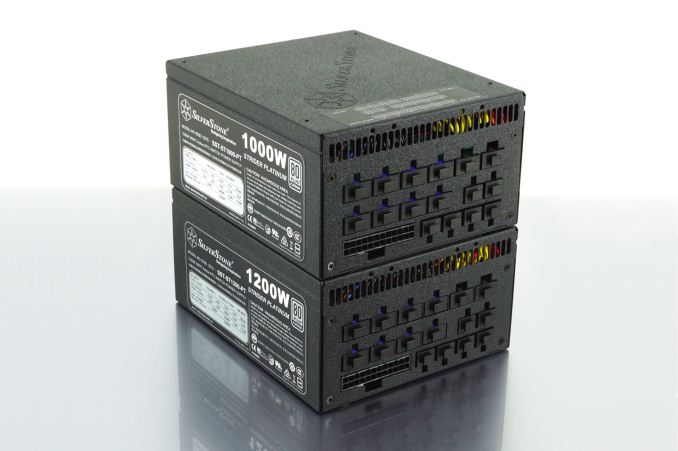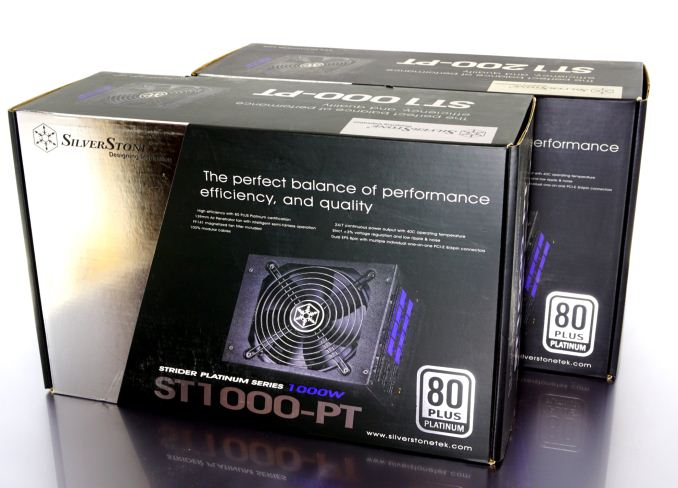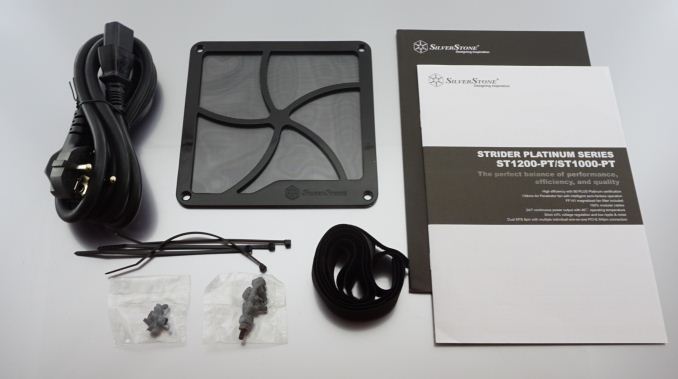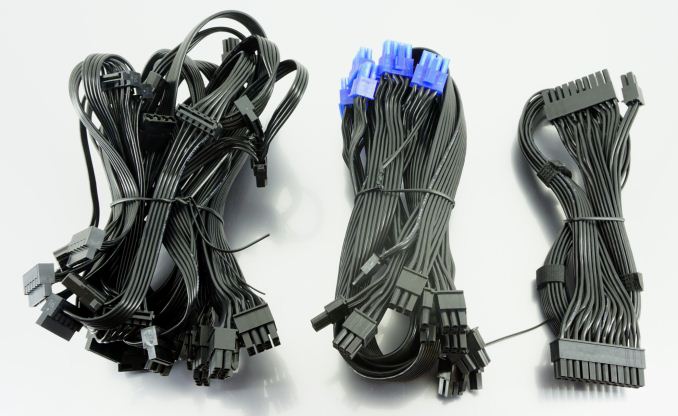The SilverStone Strider Platinum ST1000-PT & ST1200-PT PSU Review: Tenured
by E. Fylladitakis on May 4, 2018 9:00 AM EST- Posted in
- Cases/Cooling/PSUs
- PSUs
- SilverStone
- 80Plus Platinum

SilverStone is one of the most reputable PC chassis and PSU manufacturers, known for their focus on small form factor (SFF) and micro-ATX designs. We have reviewed numerous of their SFX PSU in the past, ranging from the cost-effective ST30SF/ST45SF to the monstrous SX800-LTI with the 0.76kW/l power density. SilverStone also produces several compact cases that do support ATX PSUs but are of limited proportions, leading the company to research methods to reduce the size of their ATX PSUs as well.
Introduction
Today we're taking a look at the Strider Platinum PSU series. The entire series consists of six units, with outputs ranging from 550 to 1200 Watts. We had reviewed the least powerful model of the series two years ago, before the series was expanded with the now two most powerful units of the series, the ST1000-PT and the ST1200-PT, which have a maximum power output of 1000 and 1200 Watts respectively. The SilverStone Strider Platinum are a reasonably-priced upgrade over the Strider Gold S for high-end gaming and workstation PCs, yet more cost-effective than the grand SilverStone Strider Titanium series.
| SilverStone Strider Platinum ST1000-PT ( Rated @ 50 °C ) | |||||
| AC INPUT | 100 - 240 VAC, 50 - 60 Hz | ||||
| RAIL | +3.3V | +5V | +12V | +5Vsb | -12V |
| MAX OUTPUT | 25A | 22A | 83A | 2.5A | 0.3A |
| 120W | 996W | 12.5W | 3.6W | ||
| TOTAL | 1000W | ||||
| SilverStone Strider Platinum ST1200-PT ( Rated @ 50 °C ) | |||||
| AC INPUT | 100 - 240 VAC, 50 - 60 Hz | ||||
| RAIL | +3.3V | +5V | +12V | +5Vsb | -12V |
| MAX OUTPUT | 25A | 22A | 100A | 2.5A | 0.3A |
| 120W | 1200W | 12.5W | 3.6W | ||
| TOTAL | 1200W | ||||
Packaging and bundle
SilverStone supplies the Strider Platinum units inside a very sturdy cardboard box. The artwork is subtle, focused on black/platinum coloring and a picture of the PSU itself. The detailed information regarding the features and specifications of the units is printed on the sides and rear of the box. Inside the box, the PSUs are well-protected between thick packaging foam pieces.
The company supplies a relatively rich bundle along with their SilverStone Platinum units. Both the ST1000-PT and the ST1200-PT share the exact same bundle. Inside the box, we found a very detailed user's manual, a regular AC power cable, black cable ties, black long cable straps, a set of black mounting screws, a set of black thumbscrews, and a magnetic nylon fan filter. The fan filter is meant to protect the PSU from dust but it can be placed anywhere on the case if the PSU's compartment already features a filter.
The ST-1000PT and the ST-1200PT also share the same type of cables and connectors, with the only exception being that the 1200W variant offers two additional PCIe connectors. SilverStone is using flat "ribbon" type cables, made using all black wires and connectors. This includes the ATX cable and the CPU/PCI-E 12V connectors. The only exception at the blue connectors at the PSU side of the PCI Express power cables. The ATX cable is made of several smaller ribbons bundled and secured together, forming a sort-of round cable.
| SilverStone Strider Platinum | ||
| Model | ST1000-PT | ST1200-PT |
| ATX 24 Pin | 1 | 1 |
| EPS 4+4 Pin | 2 | 2 |
| EPS 8 Pin | - | - |
| PCI-E 6+2 Pin | 6 | 8 |
| PCI-E 8 Pin | - | - |
| SATA | 16 | 16 |
| Molex | 6 | 6 |
| Floppy | 2 | 2 |













21 Comments
View All Comments
Samus - Saturday, May 5, 2018 - link
I'm still rocking an 11 year old PCP&C 750 Quad. 80 Plus something or other rating. I think it was rated 80 Plus before there were even sub-categories of 80 Plus.notashill - Tuesday, May 8, 2018 - link
I had the same PSU but it died (for the second time, first was under warranty and it was repaired not replaced) about a year and a half ago. Still not a bad service life.DanNeely - Tuesday, May 8, 2018 - link
That was a very good supply in its day, and is probably fine to keep using in whatever you've got it in for as long as you keep it. I'd be hesitant to install it in a new built system today though.I can't find any reviews that did a cross load test on it; but from its age it's almost certainly a design with separate 12V and 3.3/5V segments whose voltages get out of spec if you put a huge load one of them and barely anything on the second (aka cross load).
That's an issue because modern systems use 12V almost exclusively and put very little load on the 3.3/5V rail (PCIe cards can draw up to 10W@3.3V, a few years ago AMD was to get the most power out of the slot, nvidia was limiting itself to the 65W available at 12V; USB draws 5V for most uses, 2.5/3.5" drives might tap 5V, but almost never touch the 3.3V line because of molex to sata adapters that leave it unpowered); which puts older PSUs into a cross load situation if you're running GPUs and load the 12V rail heavily. Newer designs avoided this by going pure 12V at the AC-DC conversion step and then making lower voltages via DC-DC conversion.
Achaios - Friday, May 4, 2018 - link
"considering that the ST1000-PT was struggling to reach the 80Plus Platinum certification limits"@E.F: You should know, since you are a PSU specialist, that Silverstone has got a history of marketing units made by Enhance, which fail to meet the Certification limits or barely make it.
Case in point, my own Silverstone Strider Gold 850W. This unit fails to meet the Gold Certification by 1-2 %. This is a year 2011 PSU and the reviewer who first noted the fact was Johnny Guru.
After, what, 7 years Silverstone learned nothing from the negative publicity and they just keep doing the same thing. Ofc such data does not concern the average buyer out there who buy PSU's b/c of attractive packaging or good price, just us enthusiasts.
Silverstone sells good, solid units, just not without flaws and not the best-of-the-best. I'd label them Tier 2 or Tier 3.
stanleyipkiss - Friday, May 4, 2018 - link
Who is Tier 1 then?praeses - Friday, May 4, 2018 - link
Seasonicpraeses - Friday, May 4, 2018 - link
... and probably FSP Group after them.Fallen Kell - Friday, May 4, 2018 - link
Tier 1 is Seasonic, FSP, Corsair, and Enermax who design (and in the case of Enermax build) their own power supplies. Many of the other ones simply use an OEM design, possibly with a few modifications, but in many cases it is simply an OEM with specific paint/color scheme, or specific cables, etc..praeses - Friday, May 4, 2018 - link
Corsair is usually Seasonic or FSP. I'm not sure that I would put Enermax in the same tier as Seasonic/FSP.piroroadkill - Monday, May 7, 2018 - link
As far as I recall, Corsair uses Great Wall for a good number of their mid-range units, and Flextronics at the very high end.